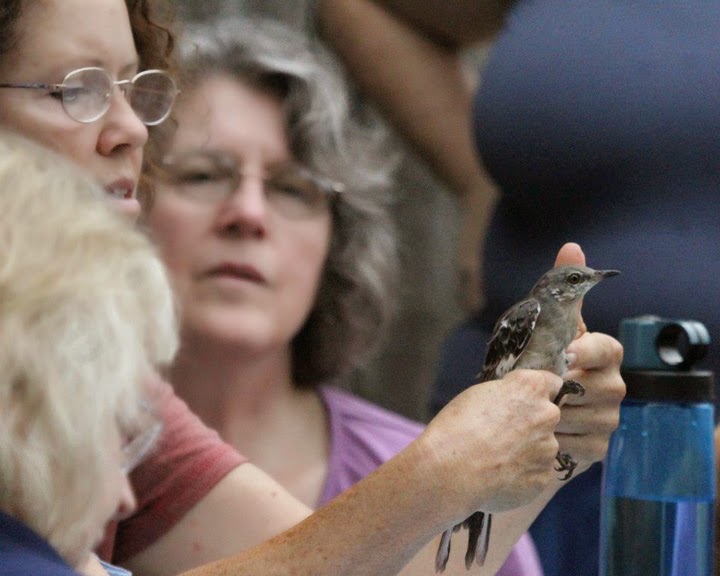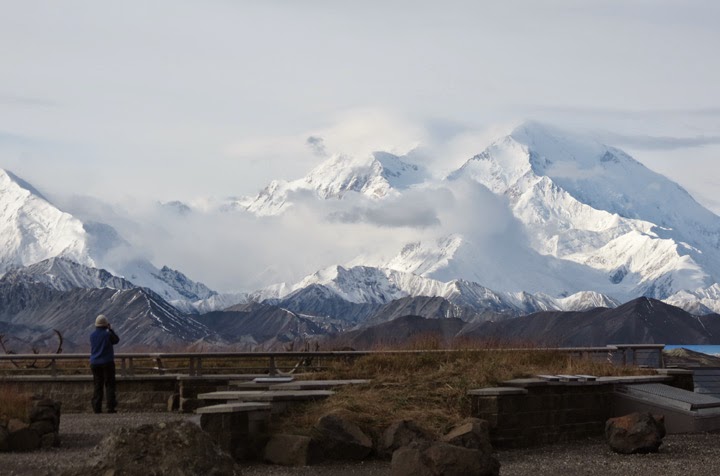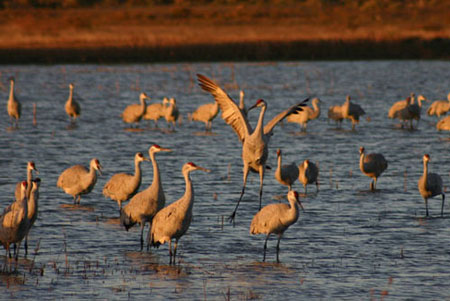
Photo credit: Wally Manspeaker
We generally think of hummingbirds as fragile to cold and as migrating to warmer climates in Mexico or Central America, where they can find nectar-producing flowers and insects. In actuality, the migration patterns and the reason for these varied patterns are not clearly understood, except that they follow food sources. Some species, such as the Allen's and Anna's on the west coast, show a northward movement in winter and not all members of the species follow the same migration routes.
Mark Armstrong, our hummingbird Master Bander in east Tennessee, reports that the Rufous hummingbirds that he captures and bands in Tennessee in the winter are healthy birds with a good supply of fat, many of them molting and replacing their molted feathers with healthy new ones. Molting and feather replacement during the winter months is an indicator that the hummingbirds are getting the nutrients they need for healthy feather production.
Photo credit: Wally Manspeaker
Wally Manspeaker lives in northeast Tennessee, in Russellville, an area of the state that is reporting many wintering hummingbirds. Tennessee's winter hummingbirds seem to be migrating through areas of higher elevation near mountain ridges and plateaus. The female Rufous Hummingbird, above, was banded by Armstrong on November 25th and has been in the area since early November.
Photo credit: Billie Cantwell
Though northeast Tennessee seems to be a popular location, hummers are showing up throughout the state. The pretty male Rufous above is spending his third winter in west Knoxville at the home of Billie Cantwell and Colin Leonard. Billie is president of the Knoxville Chapter of the Tennessee Ornithological Society and the organizer of KTOS's annual Wonder of Hummingbirds Festival.
Photo credit: Billie Cantwell
Above and below, you see the same Rufous male as a juvenile who first arrived for the winter in December of 2011.
If you think people become attached to their summer hummingbirds, imagine being host to a wintering individual that returns each year, or if you are one of the lucky ones to have successive visitors, the excitement of wondering what wintering species will visit your home next! Biologists believe that as generations of hummingbirds migrate in an easterly direction, the clumping of wintering birds will change, and wintering hummingbirds will spread out into broader territories.
Imagine being as comfortable seeing a hummingbird during winter months as we are seeing a White-throated Sparrow or a Hermit Thrush.
Photo credit: Kathy Sellars A probable female Rufous in northwest Tennessee, in Dyersburg, that arrived around the first of November.
And here is a treat for you from my artist friend, Elva Paulson, in Oregon, who enjoys investigating and sketching nature. She clearly is also an excellent photographer! Her curiousity led her to a willow grove where she settled into a spot to photograph and sketch the wildlife that visited sapsucker wells drilled in the willow bark.
Photo credit: Dale and Elva Paulson
She caught these beautiful images, above and below, of female Rufous hummingbirds visiting sapsucker wells drilled in the willows. On this occasion, she encountered at least three hummingbirds visiting the sap wells, though they were intolerant of each other's presence, and chased each other. Hummers are as aggressive about protecting sap sources as they are flower nectar.
Photo credit: Dale and Elva Paulson
In the Birds of North America's Online account of the Rufous Hummingbird's feeding habits, the Rufous species is said to feed on sap and insects attracted to sap from wells excavated by Red-naped Sapsuckers. The Rufous species breeds in the northwestestern states up into Canada, including Oregon. In the spring, when arrival on breeding grounds precedes the blooming of flowers, the Rufous feeds on sap wells released from the bark of willows and alders.
Though observations of wintering hummingbirds foraging in the southeast are still rare, this feeding behavior also makes sense in Tennessee, as wintering Yellow-bellied Sapsuckers arrive, excavating sap wells that also provide a nectar source for wintering hummingbirds.
Visit Elva's Field Notes--Look Who Came to Dinner to read the story of her encounter with hummingbirds in the willows and see her beautiful field sketches. She also describes another earlier encounter in Sweet and Sour Dinner: More About Sapsuckers.
Links and Resources:
Western Hummingbirds Wintering in Tennessee
Allen's Hummingbird in Tennessee
Rufous Hummer in Knoxville
In recent years, fourteen species of hummingbirds have been documented in the east during fall and winter months. In east Tennessee, report sightings to Mark Armstrong at Woodthrush@bellsouth.net or 865-748-2224. For a list of contact information for other eastern areas, visit winter reporting on the Hummingbird Study Group website or report sightings to Bob and Martha Sargent, Rubythroat@aol.com or 205-681-2888.
Other blog posts on Wintering hummingbirds in Tennessee
Visit Bob Sargent's information on wintering hummingbirds
Bob Sargent describes the Rufous Hummingbird as very cold-hardy.
Sargent on wintering Calliopes and the Allen's Hummingbird
Hummingbird banding
Hummingbirds in watercolor
Hummingbird art on Vickie's Sketchbook blog
Cornell's All About Birds: Rufous Hummingbirds

















I'm honored to be part of your blog post. …. and find it interesting that your winter hummers can find enough food for a successful molt. I always feel a little sorry for hummers in winter, but they are turning out to be tougher than I thought.
ReplyDeleteI was delighted to see you August post and remembered it when I recently read about the Rufous species feeding on sapsucker wells. Reading your experience and seeing the photos makes this aspect of their foraging come alive. Thanks for being so observant and sharing this experience with us!
Delete